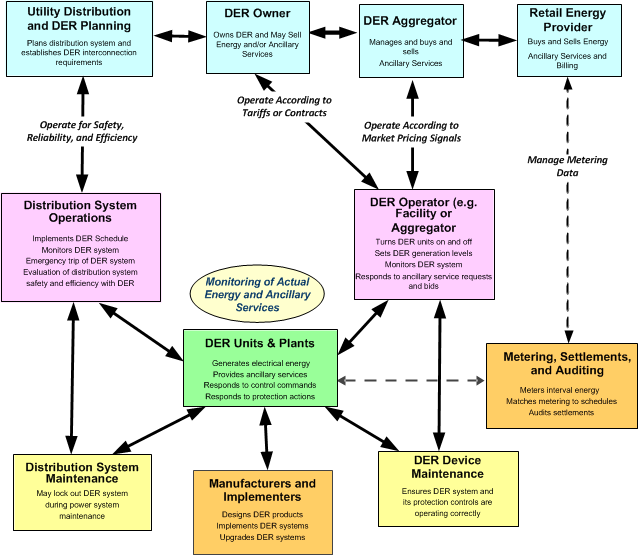2.1 Why Are Distribution Systems Becoming an Issue for Regulators?
2.1.3 Who Are the New Stakeholders in Distribution and DER Management?
Although utilities must still be in charge of managing distribution systems for reasons of safety and reliability, they are no longer the only stakeholders that must be involved. The new stakeholders include:
- DER owners, often customers of the utility, who are installing DER systems primarily to offset their loads, but can provide energy and possibly ancillary services to the utility as well
- Third party DER aggregators, who are selling or leasing DER systems to customers, and are acting in their behalf to utilities.
- Retail energy providers, who do not directly manage DER systems, but provide attractive tariffs and billing services to customers.
- DER operators, who may be facility managers or may be aggregators with permission to manage the DER systems
- DER manufacturers, who are updating their DER systems, possibly with more advanced functionalities.
- Distribution planning, who must plan for increased amounts of DER generation, who must undertake studies to ensure that DER installations meet the power system requirements for reliability and safety, and who must approve which DER advanced functions may or must be implemented.
- Distribution operations, who must operate their distribution system with high penetrations of DER systems even though they may have imperfect knowledge of generation, storage, and load patterns.
- Distribution maintenance personnel, who must safely maintain the distribution system even though DER units could potentially cause harm.
- DER maintenance personnel, who must ensure that the DER systems remain in compliance with the utility interconnection requirements.
An overview of these stakeholders is shown in Figure 2.

Figure 3 : Stakeholders in DER Management
Distribution system planning and operations are experiencing a paradigm shift as new technologies and declining costs of these technologies provide the opportunities for customers and many different third parties to actively participate in using and managing energy. The distribution system of the future will not just be supplying power out to the customers, but will transfer power to and from customers (see 3.6 and 3.4). Third parties will help to manage generation, storage, and controllable loads (see 3.7). Customers will actively participate rather than passively receive power (See 3.10).